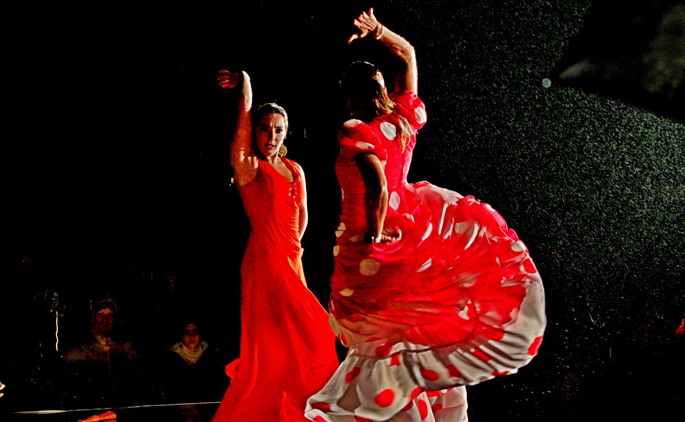Buleria is a fast, energetic cante chico flamenco form that belongs to the Solea family. It was originally played as an upbeat ending to Solea or Alegria and eventually evolved into a distinct form in its own right. The letras of buleria are often humorous and laced with mockery and social commentary.
Buleria is most commonly played por media (on the fifth string in A phyrgian, relative to the capo), but can sometimes be heard in other keys. It is generally played at a very fast tempo, ranging from 200 to 260 beats per minute.
The compas of buleria is based on a twelve count pattern similar to solea. Like solea, this pattern emphasizes the 3, 6, 8, 10, and 12 beats, but in buleria, musical phrases begin on the 12 count:
12 1 2 3 4 5 6 7 8 9 10 11
The most basic buleria marking progression uses just two chords: A and B♭. When accompanying a singer, the guitarist plays chords that follow the singer. When playing buleria as a solo piece, guitarists assemble rhythmic patterns, short chord progressions, and pre-composed or improvised falsetas to build a musical idea around a central theme.
Basic Buleria Rhythm
The basic buleria rhythm, played here by Curro Montoya of flamencoeduca.com por media, demonstrates buleria’s tempo and drive. A solo composition would use phrases like these before and between falsetas.
Buleria Stylistic Variations
Musicologist Faustino Núñez traces the origin of buleria to Jerez, possibly sometime in the late 19th century. Jerez de la Frontera is often most associated with buleria these days, as are the smaller towns of Utrera and Lebrija. Each of these individual locales brings a particular flavor to the toque (guitar playing).
Diego del Gastor
Diego del Gastor, celebrated patriarch of the guitar playing style of Moron de la Frontera, approaches buleria with an emphasis on rhythm, strong accents, and focuses on expression rather than technical prowess.
Modern Buleria
Many of these themes can still be heard in the more modern and nuanced playing of guitarists who bring classical and jazz influences to the form. Paco de Lucia and Tomatito, for instance, have both pushed the boundaries of buleria, all the while ensuring its basic essence doesn’t suffer.
Accompanying Dancers
In choreographed performances and informal gatherings alike, buleria is often structured in a “dance-off” style where dancers tease one another, spoof the audience, and generally show off their stuff. Intricate palmas and jaleo (shouts of encouragement) are also common to buleria performance.
Buleria dance accompaniemnt includes several distinct moments of interaction between a guitarist and dancers:
- Entrada: when the dancer comes on stage
- Llamada: from the verb “llamar,” to call. The dancer calls to the other people on stage that something is about to happen, for example a new verse or section of footwork
- Desplante: a “display,” a short section of footwork
- Letras: dance that traditionally accompanies passages of singing. Chord progressions suggesting the letra may be included even when a singer is not present.
- Escobilla: long passages of footwork (though not too long – in buleria in particular this is frowned upon)
- Cierre: a closing dance pattern, often one moving across the stage
To learn more about dance accompaniment, check out the Introduction to Flamenco Dance Accompaniment article here on Ravenna Flamenco.

